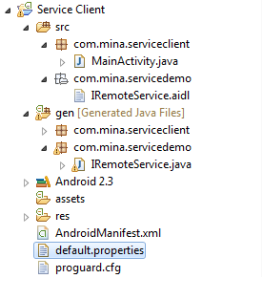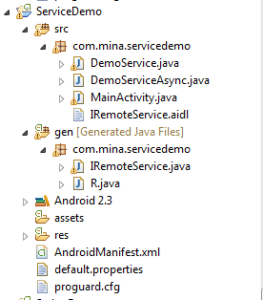Android App Development: Implementing remote Android Services with AIDL
In the last post we saw how to use Android services to do time consuming operations in the background. in this post we will see how can a client application call the methods of a service defined in another application. this is achieved through Android Interface Definition Language (AIDL).
AIDL is a java like language that enables you to define an interface that both the application defining the service and the client application implement it.
the interface defines the functions that are needed to be called in the client application.
Defining the AIDL file:
AIDL syntax is similar to that of Java, we can use the following data types in AIDL:
- primitive data types: int, long, char, boolean,….
- String.
- CharSequence.
- List (ArrayList,Vector,…).
- the AIDL file is defined as follows:
open a notepad file and paste the following code in it:package com.mina.servicedemo; // service interface interface IRemoteService { //sample method String sayHello(String message); }take care of the package name com.mina.servicedemo.
we defined a methods sayHello(String message) that returns a string. - save the file with the name IRemoteService and change it’s extension to .aidl.
- copy the file to the src folder of your project.
- once you save and build the file, Android generates an interface java file with the name IRemoteService.java in the gen folder if the project.
Defining the Service:
now we want our service to expose this interface to client applications, so we return an implementation of the service in the onBind() method of our service:
package com.mina.servicedemo;
import com.mina.servicedemo.IRemoteService.Stub;
import android.app.Service;
import android.content.Intent;
import android.os.IBinder;
import android.os.RemoteException;
import android.widget.Toast;
public class DemoService extends Service {
@Override
public IBinder onBind(Intent arg0) {
return mBinder;
}
// implementation of the aidl interface
private final IRemoteService.Stub mBinder=new Stub() {
@Override
public String sayHello(String message) throws RemoteException {
return "Hello "+message;
}
};
}
}
the last thing to do in the service is to make its exported attribute in the AndroidManifest.xml file set to true like this:
<service android:name="DemoService" android:exported="true"></service>
our app structure can be like this:
Consuming the service at the client application:
now to our client application where we want to invoke methods from our service. the client application is a separate application with a different package name than that where the service is defined.
the client application needs a reference to the AIDL interface defined in the original applcation, this is done through the following steps:
- in the client applicatio create a package with the same package name of that the service is defined in: com.mina.servicedemo.
- copy the AIDL file in this package.
- save and build and a new file called IRemoteService.java is generated. your app structure should be like this:

and we invoke the servcice methods in our activity like this:
package com.mina.serviceclient;
import com.mina.servicedemo.IRemoteService;
import android.app.Activity;
import android.content.ComponentName;
import android.content.Context;
import android.content.Intent;
import android.content.ServiceConnection;
import android.os.Bundle;
import android.os.IBinder;
import android.os.RemoteException;
import android.util.Log;
public class MainActivity extends Activity {
IRemoteService mRemoteService;
/** Called when the activity is first created. */
@Override
public void onCreate(Bundle savedInstanceState) {
super.onCreate(savedInstanceState);
setContentView(R.layout.main);
Intent serviceIntent=new Intent();
serviceIntent.setClassName("com.mina.servicedemo", "com.mina.servicedemo.DemoService");
boolean ok=bindService(serviceIntent, mServiceConnection,Context.BIND_AUTO_CREATE);
Log.v("ok", String.valueOf(ok));
}
private ServiceConnection mServiceConnection=new ServiceConnection() {
@Override
public void onServiceDisconnected(ComponentName name) {
// TODO Auto-generated method stub
}
@Override
public void onServiceConnected(ComponentName name, IBinder service) {
// get instance of the aidl binder
mRemoteService = IRemoteService.Stub.asInterface(service);
try {
String message=mRemoteService.sayHello("Mina");
Log.v("message", message);
} catch (RemoteException e) {
Log.e("RemoteException", e.toString());
}
}
};
}
and that’s was all about calling remote services with AIDL, stay tuned for another Android tutorial






 android
android 